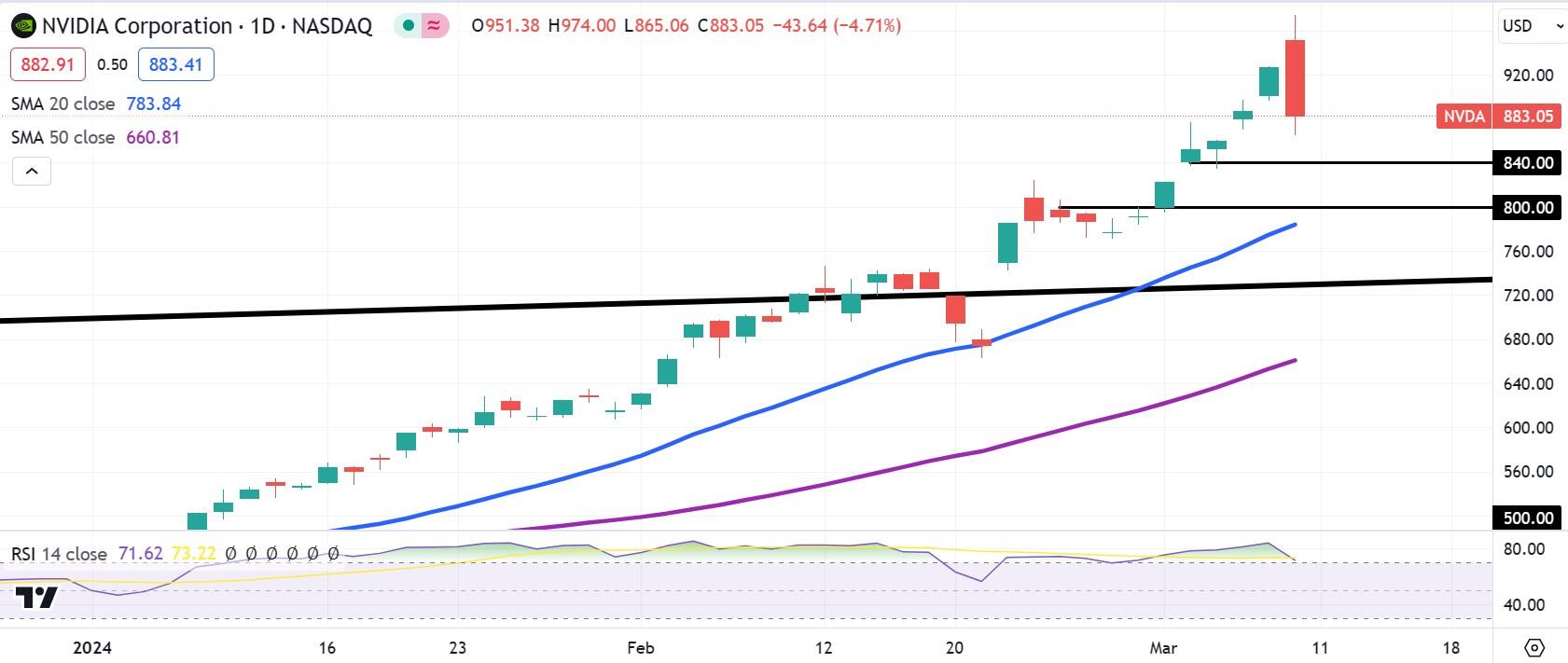- US NFP revisions worry the market on Friday.
- The unemployment rate rises to 3.9%, above the expected 3.7%.
- China creates $27 billion investment vehicle to produce advanced chips.
- The Nasdaq falls 1%, while Nvidia loses 5%.
The actions of Nvidia (NVDA) fell more than 5% on Friday after US nonfarm payrolls (NFP) data for February distressed the market. February hiring beat consensus, but January data saw a large-scale downward revision, while the unemployment rate rose to match a two-year high at 3.9%.
Nvidia closed Friday down 5.6% at $875.28, while the S&P 500 fell 0.65% and the Nasdaq fell 1.16% in an unusually volatile session. Arm Holdings (ARM), Advanced Micro Devices (AMD) and Super Micro Computer (SMCI) They also closed the session lower.
Nvidia News: February NFP, Unemployment Lead Market Down
On Friday morning, the US Bureau of Labor Statistics reported that the US economy added 275,000 jobs in the month of February. This figure far exceeded the 200,000 jobs previously estimated.
However, the market focused on the deep revision of the January figure. Arguably, January's rise to 353,000 was the main cause of Wall Street and the Federal Reserve (Fed) delaying the timetable for the first interest rate cut until June. In this report, the January figure has been revised downwards to 229,000 people. This makes the market wonder if the February figure of 275,000 will not also be revised downwards.
At the same time, the unemployment rate rose to 3.9%, which is a big difference from 3.7% the previous month. Investors compared the rise in unemployment to data on average hourly earnings, which only rose 0.1% from January. That rate was well below the consensus of 0.3% and the January rate of 0.5%. Taken together, some analysts see the February report as a sign that the U.S. economy is weakening.
Slower economic growth and a weaker labor market should give the Fed more reason to cut rates sooner, but the market appears concerned Friday that the data is telling a more worrying story. US Treasury yields fell across all maturities except the 30-year as investors flocked to the safe-haven asset.
In other news, China's National Integrated Circuit Industry Investment Fund, called the Big Fund, has proposed raising another $27 billion for a third semiconductor investment vehicle. The Big Fund has already invested $45 billion in the domestic chip industry, aiming to increase Chinese self-sufficiency in the field of semiconductors.
The Biden administration has tightened sanctions against the supply of major chips, such as Nvidia's H100, to Chinese companies, so this fund would target investments that could counter Western sanctions by producing smart chips. artificial in the country.
Forecast on Nvidia
Nvidia stock pulled back on Friday in what seems quite necessary as the stock has been firmly up all year. Just on Thursday, NVDA shares hit an all-time high of $927.67, reaching a market capitalization of $2.3 trillion. The Relative Strength Index (RSI) has been overbought for some time, which typically requires a period of consolidation, also known as a cooling-off period.
Nvidia's intraday low was $865. If it breaks below that level, both $840 and $800 are the next levels to watch. On March 4 and 5 it bottomed near $840, while $800 cushioned the price action from February 26 to March 1, acting as resistance and support. The 20-day SMA is also pointing towards the $800 level, giving it more importance. That said, a major pullback could see NVDA stock re-top the upper trendline at $730 that kept Nvidia stock down from 2020 through February of this year.
NVDA Daily Chart
Source: Fx Street
I am Joshua Winder, a senior-level journalist and editor at World Stock Market. I specialize in covering news related to the stock market and economic trends. With more than 8 years of experience in this field, I have become an expert in financial reporting.








